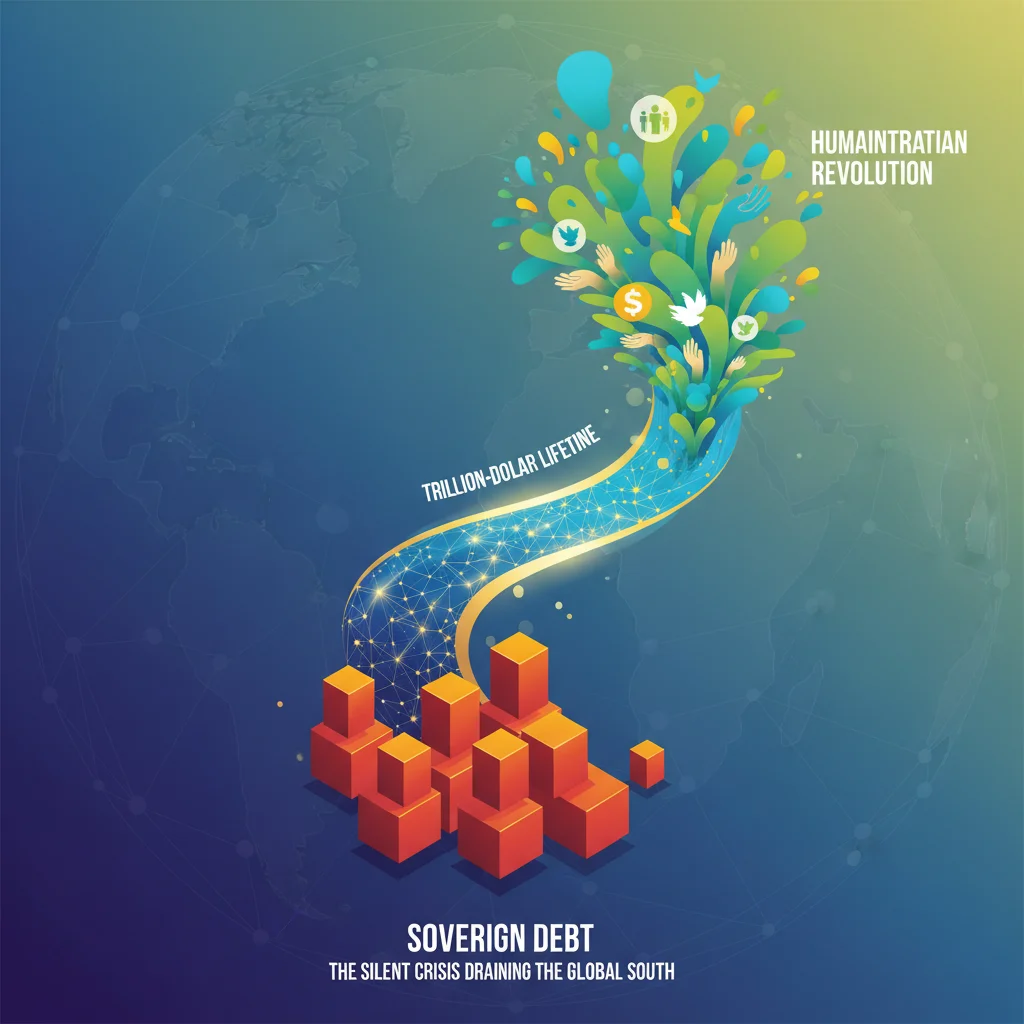
The Trillion-Dollar Lifeline: How Restructuring Sovereign Debt Can Fuel a Humanitarian Revolution
The Silent Crisis Draining the Global South
In the intricate world of global finance, numbers often tell a story. But some stories are more urgent than others. Imagine a scenario where developing nations, home to billions of people, are spending more money servicing their debts than they are on the health, education, and well-being of their citizens. This isn’t a hypothetical exercise; it’s the stark reality of our modern economy. A quiet but devastating crisis is unfolding, where interest payments have become a financial vortex, pulling essential resources away from the very foundations of human development.
According to a sobering analysis by former UK Prime Minister Gordon Brown, developing countries are now facing their most severe debt crisis in a generation. Debt payments for these nations have reportedly doubled in just two years, creating a fiscal chokehold that stifles progress. This isn’t merely a line item on a national balance sheet; it’s a direct trade-off between paying foreign creditors and funding a child’s education, a pregnant mother’s healthcare, or critical infrastructure for clean water. The situation has escalated from a development challenge into what can only be described as a humanitarian catastrophe in the making.
For investors, finance professionals, and business leaders, this is more than a distant problem. It’s a fundamental threat to global economic stability, a barrier to emerging market growth, and a test of our financial system’s ability to innovate for the greater good. The question we must now confront is: can the sophisticated tools of modern finance be repurposed not just for profit, but for progress? The answer is a resounding yes, and the blueprint for this transformation is already within our grasp.
The Vicious Cycle: How Debt Strangles Economic Growth
To understand the solution, we must first appreciate the mechanics of the problem. Sovereign debt, when managed correctly, is a vital tool for national development. It allows governments to invest in infrastructure, technology, and public services that fuel the economy. However, a perfect storm of the Covid-19 pandemic, soaring global interest rates, and stubborn inflation has turned this tool into a trap for many low and middle-income countries.
The cycle is vicious. As a country’s debt burden grows, its credit risk increases. Lenders, in turn, demand higher interest rates to compensate for this perceived risk, further inflating the debt payments. This forces governments into a perpetual state of fiscal austerity, cutting spending on the very things that drive long-term economic growth—education, healthcare, and infrastructure. The result? The economy stagnates or shrinks, tax revenues fall, and the ability to service the debt diminishes, which pushes interest rates even higher. It’s a doom loop that entrenches poverty and erodes investor confidence.
Consider the allocation of a hypothetical national budget under these two different scenarios. The table below illustrates the dramatic shift in priorities when debt service costs are brought under control.
| Budget Allocation | Scenario A: High Debt Burden | Scenario B: Restructured Debt |
|---|---|---|
| Debt Interest Payments | 35% | 15% |
| Healthcare Spending | 10% | 20% |
| Education Spending | 12% | 22% |
| Infrastructure & Development | 8% | 18% |
| Other Government Services | 35% | 25% |
As the table demonstrates, simply lowering the cost of debt can unlock a massive “development dividend.” The 20% of the budget freed from interest payments in Scenario B is reinvested directly into human capital and productive assets, creating a virtuous cycle of growth, stability, and improved creditworthiness. This isn’t just about fiscal responsibility; it’s about fundamentally altering a nation’s economic trajectory.
What’s being proposed isn’t a handout; it’s a strategic de-risking of the global financial system. The rise of ESG (Environmental, Social, and Governance) investing shows a clear market appetite for assets that deliver both financial returns and positive impact. By creating new, guaranteed financial instruments that fund development, we are essentially creating a new asset class. These are opportunities for long-term, stable returns in markets that, once unshackled from debt, have immense growth potential. This is the next frontier of impact investing—a chance to align portfolios with global stability and unlock value in the process. We should view this not as a cost, but as one of the most critical investments in our collective economic future.
A Blueprint for Change: The “Debt-for-Humanity” Swap
The concept of restructuring debt is not new. The history of international finance is dotted with initiatives designed to resolve sovereign debt crises, from the Brady Bonds of the 1980s to the Heavily Indebted Poor Countries (HIPC) Initiative of the 1990s. The current proposal, championed by leaders like Gordon Brown, builds on these precedents with a modern twist, leveraging the power of multilateral development banks (MDBs) like the World Bank and the African Development Bank.
The core idea is ingeniously simple: use guarantees from these highly-rated MDBs to lower the cost of borrowing for developing nations. Here’s how it works:
- The Guarantee Mechanism: An MDB provides a partial or full guarantee on new bonds issued by a developing country. This guarantee acts as a powerful insurance policy for investors.
- Reduced Risk, Lower Interest: With the backing of a AAA-rated institution, the perceived risk of these new bonds plummets. Investors are therefore willing to accept a much lower interest rate. A country that might have been borrowing at 10-12% could potentially issue new debt at 4-5%.
- The Swap: The country uses the proceeds from this new, cheaper bond to pay off older, more expensive loans held by private creditors.
- The Social Covenant: Here is the crucial innovation. The savings generated from the lower interest payments are not just absorbed into the government’s general fund. Instead, they are contractually ring-fenced and directed towards specific, measurable targets in education, health, and climate adaptation.
This model transforms a crippling liability into a dedicated funding stream for human development. It’s a market-based solution that respects the roles of both public and private capital. Such a mechanism could unlock hundreds of billions of dollars. One proposal suggests that just $25 billion in MDB guarantees could mobilize up to $100 billion in new, affordable financing for struggling nations.
The role of modern financial technology is paramount in making this vision a reality. Fintech platforms can enhance the transparency and efficiency of these swaps. Imagine using blockchain-based smart contracts to automate the flow of funds, ensuring that the interest savings are verifiably deployed to the intended schools and hospitals. This level of transparency would build immense confidence among investors and donor nations, accelerating the adoption of these innovative financial instruments.
The Call to Action for Investors and Financial Leaders
This is not a conversation that belongs only in the halls of the UN or the IMF. It is a critical discussion for every investment committee, banking executive, and trading desk. The private sector is not a bystander in this process; it is an essential partner.
For investors, the emergence of MDB-guaranteed social bonds represents a compelling new asset class. These instruments offer a unique blend of safety (due to the guarantee), reasonable yield (often higher than developed-world government bonds), and measurable social impact. As the ESG market matures, investors are increasingly demanding assets that can pass rigorous impact audits, and “debt-for-humanity” bonds are tailor-made for this purpose. They offer a clear, quantifiable link between the investment and positive social outcomes.
For the wider banking and finance industry, the challenge is to build the architecture for these new markets. This means developing standardized frameworks for social covenants, creating platforms for trading these new instruments, and building the analytical tools to price and manage their risk. This is a moment for innovation in product development, moving beyond traditional sovereign debt analysis to incorporate metrics of human development and social return on investment.
The historical precedent is clear. When the financial community has rallied to solve a systemic crisis, it has succeeded. The HIPC initiative, for example, delivered $100 billion in debt relief that enabled millions more children to attend school. We now have an opportunity to launch a 21st-century version of this success story, supercharged by today’s more sophisticated financial tools and a deeper understanding of sustainable economics.
Conclusion: A Fork in the Road for the Global Economy
The global economy stands at a critical juncture. Down one path lies a future of cascading defaults, deepening poverty, and heightened geopolitical instability—a future that is bad for business and terrible for humanity. Down the other path is a future where financial innovation is harnessed to solve one of our most pressing challenges, creating a more stable, equitable, and prosperous world for all.
Restructuring debt for humanitarian ends is not a radical idea; it is a profoundly rational one. It acknowledges the interconnectedness of our global system, where the health of emerging economies is directly linked to the prosperity of developed ones. It aligns the power of capital markets with the fundamental goals of human progress. For the leaders of finance, business, and government, the choice is clear. It is time to move beyond discussion and begin the urgent work of building this more resilient and humane financial architecture.


